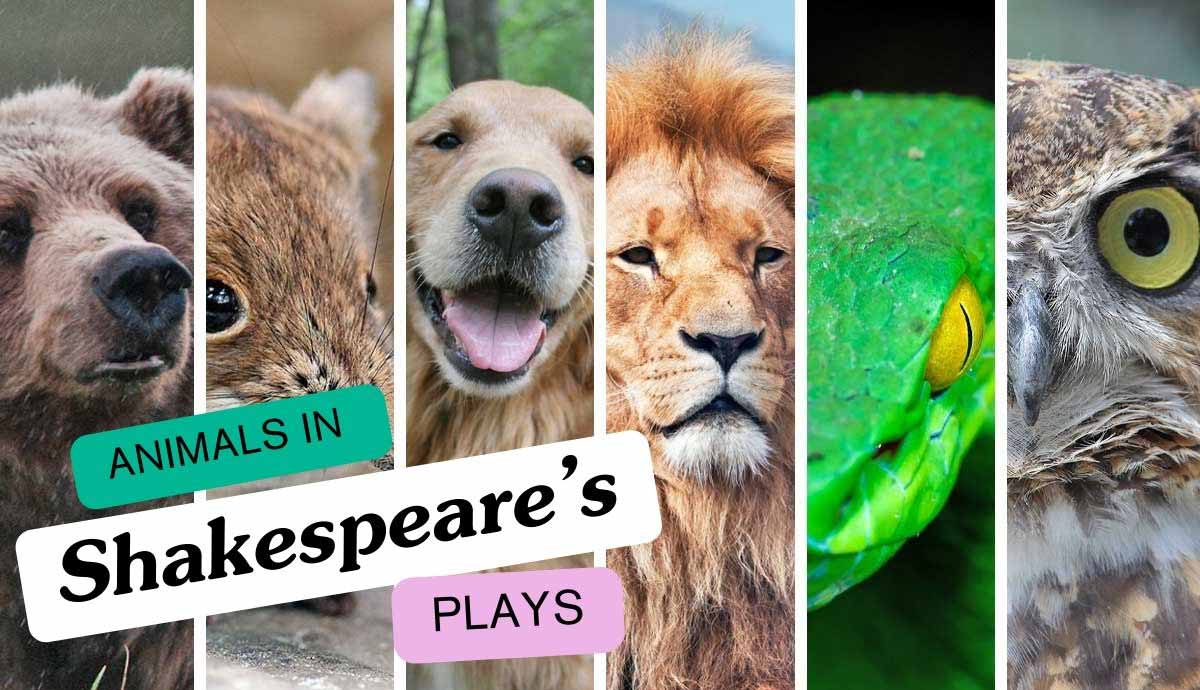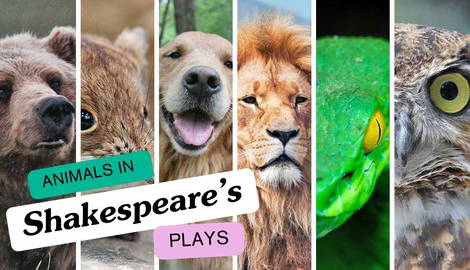
While bears and chimps may be exotic animals only glimpsed in zoos in England today, at the time Shakespeare was writing they would have been far more commonplace. The gruesome traditions of blood sports including bear baiting, cock fights and even chimpanzee gladiatorial matches are closely intertwined with that of the theatre of Shakespeare’s day. In addition, certain animals held cultural significance in the folklore and history that inspired his works. Furthermore, animal symbolism is used in a more poetic way, often revealing personality traits of Shakespeare’s cast of diverse characters.
A Bear in The Winter’s Tale

Starting with arguably the most famous stage direction in theatre history “Exit, pursued by a bear.” Shakespeare uses this fearsome creature to dispatch the selfless Antigonus who has travelled with the exiled baby Perdita, giving her the chance to live and thrive in her new life. The Winter’s Tale is a fantastical play spanning over 16 years (a rarity, when most of his works cover condensed time frames).
The bear attack takes place off stage, presumably due to practical considerations as we learn from a shepherd who witnessed the killing, that the bear does indeed eat Antigonus. Though fairy tale like to a modern audience, Shakespeare’s original audience would have felt a visceral shudder at the detail as bears would be a familiar sight and form of entertainment.
The Shrew in The Taming of the Shrew

The only animal to appear in a title of a Shakespeare, the ‘shrew’ here has dark connotations. To ‘tame a shrew’ alludes to the practice of Elizabethan men controlling unruly wives. In reality, shrews are timid creatures who can die of shock. However, the common metaphor of shrews as evil or quarrelsome women (and men in some cultures) was well established by the time Shakespeare was writing his play.
This idea was founded on the Roman belief that shrews were poisonous. In The Taming of the Shrew, Shakespeare presents a problematic examination of a ‘shrewish’ woman, Katharina, abused and coerced into submission by her husband, Petruchio. Due to the disturbing scenes of violence and emotional abuse, the play is considered a challenge to modern directors.
A Dog in Two Gentlemen of Verona

England is renowned as a nation of animal lovers, so it is perhaps surprising that there is only one pet dog in all of Shakespeare’s plays. The dog is unique in that it appears on stage (and has been played by various breeds in productions over the years), and it is whimsically named ‘Crab’. Belonging to the upbeat servant, Launce, Crab appears to love mischief as much as his master does. According to Launce, Crab is notorious for stealing a chicken leg at a banquet and for urinating on a lady’s skirt. What is notable is the undeniable bond between man and dog that reflects modern attitudes to pet ownership in a way not seen in the rest of Shakespeare’s works.
The Lion in A Midsummer Night’s Dream

This magical comedy has many unusual supernatural and real creatures. One animal oddity, though, appears in the ‘play within a play’ toward the end of the show: a lion. Given that the play is set in an imagined version of ancient Greece, complete with the wood of Athens and the austere court, a lion may seem out of place. However, lions hold great significance in ancient Greece. As well as being a recurring motif in myths (such as the Nemean lion sought by Hercules), real lions would have lived in the woods of Athens as described by Shakespeare. In Shakespeare’s play, an actor is playing a lion in ‘The Most Lamentable Comedy and Cruel Death of Pyramus and Thisbe.’
However, the players are concerned that the lion will be too terrifying for the audience. An idea that is a little more credible given that the characters would have known real lions stalked their environs.
An Asp (or Viper) in Anthony and Cleopatra

Similar to the deadly bear in The Winter’s Tale, the asp in the Tragedy of Anthony and Cleopatra plays a vital role in the plot. In Shakespeare’s work, his tragic heroine entices an asp to bite her and thus bring about her death rather than being captured by the conquering Romans. While this event is inspired by the historical records of Plutarch, historians are divided on the validity of this claim. In Roman Egypt, asps (or vipers) were a symbol of royalty and therefore a suitable means of death for higher class prisoners set to be executed.
According to some sources, the real Cleopatra experimented with a variety of poisonous ‘asps’ on condemned prisoners to help her choose the best method for her own death.
‘Asps’ is an abbreviated term from ‘aspis’, meaning viper and simply referred to all the venomous snakes of the Nile region. The asp referred to in Shakespeare’s play is most likely now known as the Egyptian cobra; a highly venomous snake.
The Famed Owl of Macbeth

There are a whole host of animals referred to in Shakespeare’s play. Most, sadly, appear as ingredients in the witches’ spells: eye of newt, toe of frog, wool of bat etc. However, there is another distinct animal reference that would have had a particular meaning to his original Renaissance audience. On the night of King Duncan’s murder, Lady Macbeth is startled by a cry in the dark. After a short pause, she consoles herself “hark, peace, it was the owl that shrieked.” She also describes the owl as a “fatal bellman”.
Shakespeare’s original audience would understand that to hear an owl (or worse, to see an owl flying over one’s house) foretold death. Furthermore, by comparing the owl to a bellman (or town crier), Shakespeare is alluding to this being the role that would announce deaths in a town. Therefore, Lady Macbeth is reassured on hearing the owl as, to her, this means that King Duncan’s death is certain.










